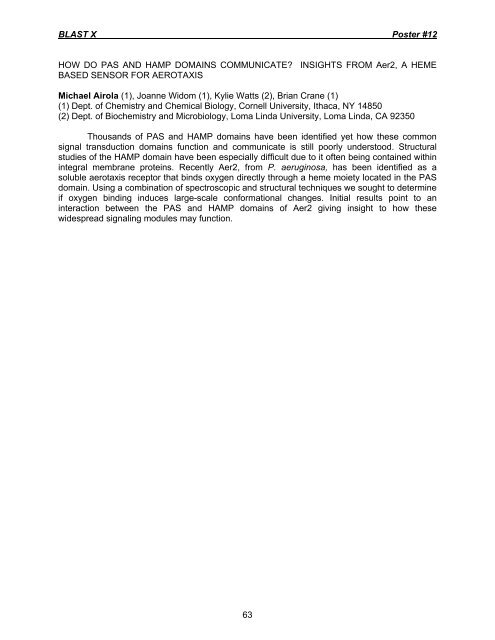POSTERS - BLAST X - University of Utah
POSTERS - BLAST X - University of Utah
POSTERS - BLAST X - University of Utah
Create successful ePaper yourself
Turn your PDF publications into a flip-book with our unique Google optimized e-Paper software.
<strong>BLAST</strong> X Poster #12<br />
HOW DO PAS AND HAMP DOMAINS COMMUNICATE? INSIGHTS FROM Aer2, A HEME<br />
BASED SENSOR FOR AEROTAXIS<br />
Michael Airola (1), Joanne Widom (1), Kylie Watts (2), Brian Crane (1)<br />
(1) Dept. <strong>of</strong> Chemistry and Chemical Biology, Cornell <strong>University</strong>, Ithaca, NY 14850<br />
(2) Dept. <strong>of</strong> Biochemistry and Microbiology, Loma Linda <strong>University</strong>, Loma Linda, CA 92350<br />
Thousands <strong>of</strong> PAS and HAMP domains have been identified yet how these common<br />
signal transduction domains function and communicate is still poorly understood. Structural<br />
studies <strong>of</strong> the HAMP domain have been especially difficult due to it <strong>of</strong>ten being contained within<br />
integral membrane proteins. Recently Aer2, from P. aeruginosa, has been identified as a<br />
soluble aerotaxis receptor that binds oxygen directly through a heme moiety located in the PAS<br />
domain. Using a combination <strong>of</strong> spectroscopic and structural techniques we sought to determine<br />
if oxygen binding induces large-scale conformational changes. Initial results point to an<br />
interaction between the PAS and HAMP domains <strong>of</strong> Aer2 giving insight to how these<br />
widespread signaling modules may function.<br />
63


